Targeting Content and English Language Objectives
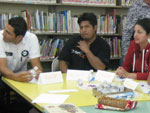
Integrating English Language Development (ELD) standards and objectives into your lesson planning can strengthen both your students' understanding of history and their language skill levels.

Integrating English Language Development (ELD) standards and objectives into your lesson planning can strengthen both your students' understanding of history and their language skill levels.
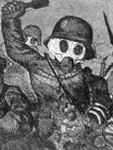
How do you teach California World History Standard 10.6.4?
10.6.4: Discuss the influence of World War I on literature, art, and intellectual life in the West (e.g. Pablo Picasso, the “lost generation” of Gertrude Stein, Ernest Hemingway).
Like most state standards, the California history-social studies content standards provide an outline of content and skills that all students should “know and be able to do.” The standards purposefully avoid pedagogy, leaving all decisions regarding how to teach the standards to teachers.
Pedagogy, however, is addressed in the Department of Education’s primary curriculum document for history education – the History-Social Science Framework. The latest edition of the Framework, stalled in the adoption process due to a lack of funding but available on-line, is meant to help teachers and administrators implement the standards. Check out the Framework’s new chapters on instruction and differentiated instruction as they provide several suggestions for “teaching the standards.”
Content Knowledge
When planning to teach any historical topic a good place to start is to develop your own content knowledge. Go beyond simply reading about the topic in the textbook and establish deeper contextual knowledge of the period. If possible, familiarize yourself with the historiographical debates surrounding the topic. This work can be done largely on-line. A good place to start is the Gilder Lehrman web-site, which includes several, short “guided readings” on World War I and the 1920s that are helpful for developing content knowledge. Similarly, you might also check out Digital History’s short essays on the Jazz Age.
Backward Planning
Before lesson planning, consider how you might embed this material in a larger unit of study - in this case, a unit on the effects of World War 1 or the 1920s. Follow a backwards design process by first establishing the learning goals and objectives for the unit. To do this, think about how post-war literature and art relate to other topics mentioned in standard 10.6 – for example, the “widespread disillusionment with pre-war institutions, authorities, and values” (10.6.3), and the “effects of the war on…population movement, the international economy, and shifts in the geographical and political borders of Europe and the Middle East" (10.6.2).
Lesson Plan: Investigating a Standards-Based Question
One approach for teaching this standard is to investigate it as a historical question: How did World War One influence literature, art, and intellectual life? Or, perhaps, How did artists interpret and depict the consequences of World War One? Begin by providing students some background content on pre-war art movements (e.g., realism and modernism) and information on artists who emerged out of the war. Next, have students examine a number of artifacts that address the question from different perspectives and genres. The standard includes some places to start searching for documents – namely, Picasso, Stein, and Hemingway. You might also take a look at T.S Eliot’s The Wasteland and Otto Dix’s painting, Assault By Gas (1924). Hemingway’s The Sun Also Rises (1926) includes some vividly dark recollections of the war and Wilfred Owens’ Dulce Et Decorum Est (How Sweet It Is) (1921) satirically captures the horrors of trench warfare. It is important here to excerpt strategically - include short passages of written work that speak directly to the lesson’s historical question.
Collaboration
Finally, yet perhaps most importantly, this standard is unique in that it promotes collaboration between history and English classes. If you are teaching a 9th or 10th grade world history course, seek out the members of your English department to see if they teach, or might be willing the teach, any literature of the “lost generation.”
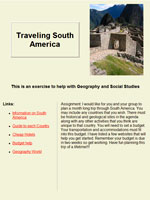
This tool should win prizes for user friendliness.
Web Poster Wizard allows educators to create a lesson, worksheet, or project and immediately to publish it online. With this tool, students can create posters or short reports in a poster format and add images and links to their pages. The teacher can post directions and resources. In effect, with Web Poster Wizard, you are creating websites for individual projects, for classes, or as communication venues.
Web Poster Wizard gives you access to online storage, step-by-step instructions, and basic project templates. Once you register and login (a simple process requiring only your email address and a password), site management tools enable you to set up your classes, to assign projects to students, provide materials and resources, and to manage content. The centralized login combines students and teachers in one account.
Read Web Poster Wizard Guidelines and Requirements first. As the Guidelines explain, all you need to get started is a plan. You then create your project pages, and each page can include a title, subtitle, image, text block (which permits 10,000 characters, or about 4 pages of text), and a navigation bar to related links. Step-by-step directions take you through setting up and editing your pages.
This 7th Grade Language Arts teacher uses Web Poster Wizard as a management tool.

Slideshare is a site for sharing presentations. It allows you and your students to upload (and download) Powerpoint, OpenOffice, or PDF presentations to the web, and to access and download the presentations of others. All that's required—besides the presentation, of course—is to open a free account.
Slideshare provides access to the work of others, and so it becomes an excellent networking or preliminary research resource. A privacy feature, however, also offers the option of limited access for work you'd rather limit to your own classroom or interest group. You can also share presentations via your blogs or websites.
The Slideshare Tour explains the many possibilities, including widgets for incorporating SlideShare in blogs or websites.
Want to know how others are teaching and learning about particular subjects? The Slideshare search function works much like YouTube. A search for web tools, for example, brings up presentations such as Using Social Media to Define the New Humanities, a how-to, Teaching with Flickr, and Teaching History with Technology. The search feature refers the user to similar presentations and to other presentations uploaded by the same author.
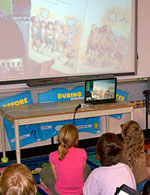
Skype is a Voice-Over-Internet Protocol (VOIP) program that allows users on different computers in different locations to videoconference via an internet connection. The free software enables both audio and audiovisual options. Use it to communicate classroom-to-classroom around the globe or across the hall. Skype enables synchronous teacher-to-teacher and class-to-class communication, and enables you to bring outside experts into the class without leaving the room.
Skyping is an uncomplicated process. A computer with a high-speed internet connection, a microphone, and a webcam (built-in or external) constitute the hardware required to begin. First, you'll download the software appropriate for your computer—for PC or Mac, and create a username and password . Then all you need to do is develop your contact list and test your equipment with a trial call.
Of course, in order to have a conversation via Skype, both parties need to be signed in. You'll find your contact list in the left side of your Skype window. When the telephone icon next to a name is green, your party is logged on and ready for a conversation or an IM. To add a contact, click the plus sign in the lower left-hand corner or use the Contacts selection in the Skype navigation bar.
Basic Skype really IS easy to use—as easy as making a phone call. What, then, can go wrong? Occasionally connections are lost or the sound goes awry. It's best to be prepared with a contingency plan about who will redial if that happens, and also to have a simultaneous IM connection to keep in touch. Testing your equipment in advance will ensure that sound and video settings are correct. You'll select and confirm your audio and camera settings under the preferences option in the drop down menu under Skype in the nav bar.
For Skype events involving a group, you'll want to add projection equipment to your setup so that everyone can see and participate. It's also possible to record Skype conversations and videoconferences for later reference and projects, including creating podcasts.
Skype helps you bridge geographic divides, work collaboratively with groups outside your classroom, and conduct question-and-answer sessions with consultants. It's a useful videoconferencing tool for professional development, and the program can help homebound students keep in touch.
Skype and other videoconferencing tools support inquiry-based learning, and like most technology tools, Skype can both augment the substance of curriculum content and serve as curriculum content area itself to teach a variety of skills. Skype (and other interviewing and collaborative experiences) occur in a proscribed timeframe, and you'll want to focus on planning skills to maximize how your class uses that allotted time. Pre-planning helps keep the conversation focused and on-topic. Discussion, and post-interview analysis of a video-conference foster both critical thinking skills about the subject and about proficient use of the technology. A well-planned Skype session encourages students to probe the problem they're working on to frame and ask thoughtful questions.
Ask students to formulate questions in advance, based upon the project or subject and to develop backup or secondary topics of inquiry. To interview a consultant or expert, students might research their interviewees biography and find any ideas that person might already have expressed about the subject of the discussion. After the videoconference, debriefings pinpoint the most valuable information and approaches and offer a chance to frame what's next.
Neil Stephenson, a middle school teacher in Canada, addresses The Many Roles of Skype in the Classroom, describing an ongoing Skype conversation with a curator at Canada's National Museum over the course of the school year as students worked on specific history projects. How did it encourage learning? Students had the opportunity to see the value of their work in the context of the work of a historian, to get feedback, and to hear firsthand about what curatorial work is and does. Stephenson talks about his first steps with Skype in the classroom and highlights examples in his blog.
The Eisenhower Middle School in Wickoff, New Jersey, recorded Skype interviews with students on field trips to historic sites and interviews.
A first grade class in Virginia talked to a penpal in London with whom they'd corresponded all year. The teacher-librarian who developed the project thought "what shocked them the most was the concept that the person they were talking to had just eaten dinner when they had just eaten lunch!"
Skype can be an excellent medium for collecting oral histories. The Educause Learning Intitiative suggests seven things you should know about Skype, citing and examples from an Arizona tribal college that would work equally well in K-12 classrooms. Students collected oral histories and recordings that were later turned into podcasts and other digital and web-based projects.
Using Skype in the Classroom from Robert Murcha, a sixth grade teacher, is a concise step-by-step-by-step guide to Skyping, including caveats about classroom management, chatting while skyping, and diction.
Skype in Schools created by Dan Froelich is an active wiki with some helpful insights on how to use Skype, on successful projects, and information about schools and classrooms looking for Skype partners.
Yes, it's another "Best of" list, however 50 Awesome Ways to Use Skype in the Classroom is a diverse set of quick links to technical, pedogogical, and collaborative possibilities using Skype.
Education Week considers the future of videoconferencing in classrooms—including the development of Skype in Education, an upcoming website created by Skype Technologies to bring together Skype-using educators.

A document camera makes a great addition to a history classroom with a video projector or TV. A document camera captures anything under its lens and projects it on the screen. While this technology has been around for a few years, it has been a little slow to catch on for a variety of reasons.
Some teachers may be hesitant to embrace the document camera because they believe it to simply be a glorified overhead projector. The document camera beats the old overhead projector in many ways, the first being that the document camera does not require one to make transparencies. A teacher can project artifacts, photos, worksheets, and anything else that can fit under the camera lens. In addition, students are better able to see the image produced by a document camera as it is much brighter and clearer than the image produced by the overhead projector. Best of all, you no longer leave school covered in overhead marker!
The cost of the document camera may also make this teaching tool seem out of the reach of many teachers and districts in these lean budget years.
While document cameras range in price from $200 to $2,000, this should not preclude one from having their own document camera. You can find a used document camera on eBay or a surplus property store for under $100. Another option is to make a document camera yourself using a webcam and available USB port. The only drawback to this setup is you have to be able to load software on your computer attached to the video projector in your classroom. A ready-made version of this runs about $69. It is also possible to obtain grant money for document cameras from places like DonorsChoose.
Once you have your document camera installation is straightforward.  Some document cameras come with a freeze image button which is a great feature to capture a page in a book or map that might be difficult to hold in place. If the document camera does not have this feature, you can hook up the document camera directly to the video projector, which often has the ability to freeze an image. If your document camera is not one that hooks up to your computer via USB, you can also set up the document camera directly to your projector. This allows you to toggle between the image on your computer screen (assuming it too is attached to your video projector) and the image from your document camera. You can also connect most document cameras to a television using an S-video cable or component video cable. It should be noted, however, that the clarity is not as crisp when using the S-video cable or component video cable compared to using a VGA or DVI connection.
Some document cameras come with a freeze image button which is a great feature to capture a page in a book or map that might be difficult to hold in place. If the document camera does not have this feature, you can hook up the document camera directly to the video projector, which often has the ability to freeze an image. If your document camera is not one that hooks up to your computer via USB, you can also set up the document camera directly to your projector. This allows you to toggle between the image on your computer screen (assuming it too is attached to your video projector) and the image from your document camera. You can also connect most document cameras to a television using an S-video cable or component video cable. It should be noted, however, that the clarity is not as crisp when using the S-video cable or component video cable compared to using a VGA or DVI connection.
The document camera has vast instructional possibilities. I have used my document camera every day in my history classroom. One of the benefits of having a document camera in a history classroom is having the ability to analyze primary sources together as a class. I am able to zoom in on important components of a photograph or text and can invite students to the document camera to annotate pictures or text without bulky markers or transparencies. I am also able to share maps in books easily with students, in color. Students are able to share work they have created immediately with the class without having to scan an image or make a transparency of the document.
This means that jigsaw activities work very efficiently, with each group able to share what they have written on nothing larger than a worksheet. Collectively, classes have created essay outlines and timelines together. The document camera allows students to share storybooks they have created, projected large enough for the class to see. From a classroom management perspective, the document camera allows me to easily show students the worksheet we are working on or the question I want them to focus on. I am also able to place my stopwatch under the camera to show students how much longer they have to complete a task. Finally, my favorite use of the document camera is allowing me to spotlight and share exemplar student work. I am able to give specific praise to a well-written essay or project.
Interested in looking at specific cameras currently available? Read product reviews for document cameras in this article from Scholastic.
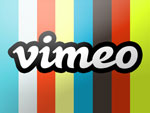
A cursory search on the web reveals an extensive online conversation over which video uploading site is better: YouTube or Vimeo? In reality, both sites offer distinct features for users and have carved distinct niches.
Vimeo caters to a smaller community of dedicated video producers. As a consequence, the amount of videos Vimeo hosts is much smaller in comparison to YouTube; however, what Vimeo lacks in volume it compensates for with consistency of video quality. Likewise, examining the comments on videos posted to Vimeo shows that its community is supportive of original productions—many of which were made as academic projects—through constructive comments. The site's community prides itself as an online venue for creators of original and high-quality video productions, and Vimeo does not accept commercial videos. For educators, then, it is a useful site (and often unblocked in school systems) when searching for safe videos to use in the classroom.
Vimeo provides users with free registration, with more features for users who upgrade to a paid account: a free account provides (as of writing) 500MB of upload space per week, 1 HD video per week, no HD embedding, the ability to password-protect videos, and basic player customization, among other features. The "plus" account, which has an annual fee, provides a much larger upload space, unlimited HD, and no banner ads on the site, among other benefits that expand on the free account. For teachers, it would be best to begin with a free account and based on the frequency make a determination of whether a subscription to the "plus" accounts makes sense. It might also prove beneficial to take advantage of the password protection for videos if there is any parental concern over student videos on the web.
Many video professionals prefer Vimeo for its ability to upload a better-quality video than YouTube. Users are able to watch their videos upload and edit the information about the video while it is uploading. Vimeo also allows different formats of videos, including HD (which YouTube has only recently added as well). As a result, Vimeo can adapt to widescreen videos without leaving black areas.
Searching for videos is a bit trickier in Vimeo. Its catalog is dwarfed by YouTube (which uploads 20 hours of footage every minute, two million new minutes of video every 24 hours.) Nevertheless, Vimeo's 13,000 daily uploads is impressive, especially when large amounts of videos are uploaded in HD each week. For a teacher, a useful aspect of the site is that videos can be downloaded—useful in the event that the school server is down. As is the case of most video hosting sites, it is important to teach students how to search effectively. Broad search terms like "Lincoln" and "rights" should be refined as "Abraham Lincoln" and "U.S. civil rights" in order to find the most appropriate videos for a given lesson or project.
A final recommendation on searching is to simply search for Vimeo history videos on Google. One example is typing "Vimeo Library of Congress" in a search engine like Google. One of the first hits is a Thomas Jefferson's Library Book Explorer video, which leads to other videos such as one on the Early Americas—which is displayed in stunning high definition.
Using the search term "Abraham Lincoln," several useful videos serve as examples of the multiple benefits of posting videos online. One use is to present student projects and use the video production as a culminating activity. Here elementary school students present their book projects on Abraham Lincoln, whereas another Lincoln video offers more of a short documentary on Lincoln and Pennsylvania that can be useful as an introduction to a lesson. A third video, while in need of audio, does provide good visuals of Lincoln's birthplace in Kentucky; the producer of the video is also part of a larger "channel" knows as Geography Educators, so here is a case where a particular video on Lincoln serves as a gateway to other useful videos for the classroom. Teachers can search for videos on Vimeo through people, channels, groups, or videos. By subscribing to Vimeo, users can save their favorites for a particular course and access them easily when needed.
To browse for specific groups and channels, the "explore" button found in the top navigation is a good place to start. Although Vimeo does not currently possess a "History" channel, the channels page lists the several categories of interest including "education." It's worth noting that education is used broadly and mostly includes do-it-yourself and tutorial videos on a wide range of subjects. To limit searches in a particular channel to course-relevant videos, users can select "search these channels." Likewise, searching for "teachers" within the group page can help educators explore groups whose focus is on curriculum videos. One example is Vimeo for Teachers, which has a wide variety of productions across several disciplines. Although only a few social studies or history videos are currently in this group, teachers can glean ideas for how to use videos in the classroom in effective ways.
Overall, Vimeo is a good site for uploading video productions from the classroom, and with enough digging teachers will be able to find useful videos for planning or instruction.
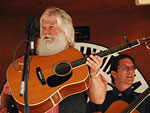
I need ideas for constructivist lesson plans that teach American history through folk music. Can you help?
Music can be a great resource for American history teachers. Just like textual primary sources, songs have historical meaning that students have to work to uncover. A song, no less than a presidential address, reflects the time in which it was created, as well as the perspective of its author. Consequently, you’ll want to ask students to consider who wrote the lyrics, what those lyrics mean, who the audience for the song was, and what was going on in the United States at the time. You might want to pair the song with other sources—newspaper clippings, radio addresses, photographs of protests, etc.—that students can piece together to better understand a particular historical era.
Folk music, of course, is distinct from popular music in one general regard: unlike music created by professional recording artists, folk music is generally made by ordinary people and integrated into everyday life. So, while many well-known artists like Woody Guthrie and Bob Dylan certainly played folk music, it can often be used as a way of better understanding the lives of people frequently left out of history textbooks. PBS’s brief history of American folk music might be a good place to start, establishing the unique nature of the genre and helping you focus your search for resources.
As always when looking for classroom resources, teachinghistory.org can help. Our Teaching in Action section, for instance, includes an example of how a song might be used in the classroom, providing links to videos in which 4th grade students learn about John Brown’s raid on Harper’s Ferry by analyzing the song “John Brown’s Body.”
Our Using Primary Sources section also has some appropriate resources for you. One entry on Making Sense of American Popular Song highlights a website that provides questions to ask when using music in the history classroom, a model interpretation of a popular song, and links to resources. Another entry, on Document Analysis Worksheets, includes a link to the National Archives, which has a special “Sound Recording Analysis Worksheet.”
Beyond the Teachinghistory.org website, you might want to look at some of the other usual suspects for high quality materials and lesson plans. EDSITEment—a project of the National Endowment for the Humanities—is always a good place to look. They have a lesson entitled “Music from Across America” that explores the intersection of music and popular song. The Library of Congress is always a good resource, and they have a full page of links, as well as some specific lesson plans like one on California folk music in the 1930s. Finally, PBS’s American Roots Music website has four lesson plans as well as a bibliography that you might find useful.
There are also some specific music-related sites worth exploring. The Rock and Roll Hall of Fame also has a page of lesson plans dedicated to teaching with music. You might also want to explore Smithsonian Folkways to see what music they have available.

How and where do I find technology content for the history classroom?
Teaching history with technology can be a great way to engage students while also building bridges between the history classroom and the technology department at your school.
One good place to start is by exploring some of the technologies available to you in the classroom. The National History Education Clearinghouse, for instance, has an article on the use of digital whiteboards in the classroom, which you might find useful. "Wiki Wisdom," an article from Education Week, focuses on how teachers can use wikis in the classroom, emphasizing their ease of use, and listing considerations accompanying their integration into the classroom. Reel American History, a project at Lehigh University, is a site that encourages teachers and students to think about the ways movies help us construct understandings of history. The site includes a list of films dealing with history, as well as suggestions for how to use them. (Check back in the coming weeks and the National History Education Clearinghouse will also have new resources about using film to teach history.)
In terms of blogs, the American Historical Association has an article on how blogs connect students outside the classroom that might be useful for your purposes. Social studies teachers, particularly those who focus on current events, may also be interested in digital storytelling. Edutopia has a great article about digital storytelling that will direct you to additional resources.
Another angle you can take in looking for resources is to pursue sites that specifically explore technology-related content for the history classroom. One great resource is National Council for the Social Studies Community Network which has a variety of resources for teaching with technology. You can also join their Teaching with Technology group to be connected with other teachers who are interested in integrating technology into history and social studies classrooms. Many other sites have resources to help you.The Center for History and New Media’s Episodes page, for instance, has multimedia resources for a number of different historical periods. SCORE, the Schools of California Online Resources for Education webpage, also has some great materials that utilize technology in the history and social science classroom. The page has a virtual web museum, virtual interactive projects, and virtual field trips. Science, Technology, and the CIA, a project of the National Security Archive, provides 44 government documents that track the organizational and operational history of various CIA departments designed to coordinate science and technology research with intelligence operations.
Another way to approach your question is to look for models of projects merging technology and history. On the National History Education Clearinghouse site, there’s a blog entry describing a project conducted at Harpers Ferry National Historic Park in which students used a host of new technologies to explore the history of Harpers Ferry and John Brown—definitely worth checking out.
Good luck with your lesson planning!
Making Sense of Maps offers a place for students and teachers to begin working with maps as historical evidence. Written by David Stephens, this guide offers an overview of the history of maps and how historians use them, a breakdown of the elements of a map, tips on what questions to ask when analyzing maps, an annotated bibliography, and a guide to finding and using maps online.